Investigating past and future climate conditions of coregonine restoration habitats: A case study of Cisco in Saginaw Bay
Contributing Authors
Joseph Langan (NOAA, joseph.langan@noaa.gov), Peter Alsip (NOAA), Jose Bonilla-Gomez (FWS), Cory Brant (USGS), David Cannon (University of Michigan), Mark Rowe (NOAA), Pengfei Xue (Michigan Technological University
Project Description
Cisco (Coregonus artedi) was once one of the most abundant pelagic fishes in Lake Huron (Koelz 1929), supporting a large fishery in Saginaw Bay throughout the early 1900s (GLFC 2022, Rook et al. 2024). The population supporting this fishery, however, began to collapse during the 1940s due to a combination of stressors including overfishing, eutrophication, and trophic interactions with invasive species (Rook et al. 2024). Due to the prominent historical role of these stressors, the present and potential future impacts of contemporary stressors such as climate change have received less research attention (Collingsworth et al. 2017). However, climate effects will likely become a driving force of fish population dynamics in the coming decades.
Improved understanding of the effects of various anthropogenic stressors on Great Lakes ecosystems has contributed to the growing interest in reintroduction and restoration of native coregonine populations through science-based efforts now guided by the Coregonine Restoration Framework (CRF, Bunnell et al. 2023). An example of such activities, the Lake Huron Technical Committee developed a recovery guide for Cisco in Lake Huron in 2007 (LHTC 2007). While Cisco is presently found in northern Lake Huron (Ebener 2012), the species is no longer observed in historically productive Saginaw Bay (Fielder & Thomas 2014). It was determined that the lack of spawning stocks in previously occupied areas like Saginaw Bay (LHTC 2007) is impeding recovery and that recent shifts in ecosystem dynamics, including declines in pelagic forage fish (Riley et al. 2008, Riley et al. 2019), may be benefiting native species (Fielder et al. 2007, He et al. 2012). Because these conditions present an opportunity to determine if Cisco can reestablish self-sustaining populations, a restorative stocking program was put in place (LHTC 2023). Targeting one offshore area in Saginaw Bay, this ongoing program is stocking and monitoring Cisco to determine reestablishment feasibility following the steps laid out in the CRF. However, these steps could be enhanced by a fuller consideration of the effects of climate change.
Although past Cisco declines in Lake Huron have been attributed to other factors, emergent dynamics related to climate change may play a more central role in the future (Collingsworth et al. 2017, Staudinger et al. 2021). Indeed in other systems, populations depressed initially by anthropogenic stressors like overfishing have exhibited persistent low abundance in spite of management actions as a result of climate effects on productivity (e.g. Langan et al. 2022a, 2022b). Past research indicates that environmental conditions, like ice cover phenology (Bonsall 2017, Brown et al. 2022, Schaefer et al. 2022, Brown et al. 2024) and egg incubation temperature (Stewart et al. 2022, Brown et al. 2024), play an important part in defining Cisco spawning habitat suitability and modulating year class strength. Furthermore, synchrony in Cisco recruitment across large spatial scales indicates that climate conditions during early life stages, a part of the life cycle that may be a bottleneck for recovery (Fielder and McDonnell 2024), are already influencing population productivity (Myers et al. 2015). While numerous interacting drivers have been hypothesized to affect Cisco recruitment, with potential differences in relative importance across the Great Lakes, there is a consensus view that large-scale climatic processes are influential in regulating early life stage growth and survival (Brown et al. 2024). Therefore, there is a clear need to consider climate information in the planning and evaluation of the success of Cisco restoration efforts in Saginaw Bay and, more broadly, actions taken under the CRF. This proposal seeks to characterize past, present, and future climate conditions experienced by Cisco spawners, eggs, and emerging larvae at the restoration site in Saginaw Bay to inform the evaluation of reintroduction success in the present and future. Furthermore, this work will serve as a case study to demonstrate how climate information derived from linked hydrodynamic and atmospheric models may support science planning activities (Research Priority 1), such as Gap Analyses or Threats Assessments, in future CRF efforts.
